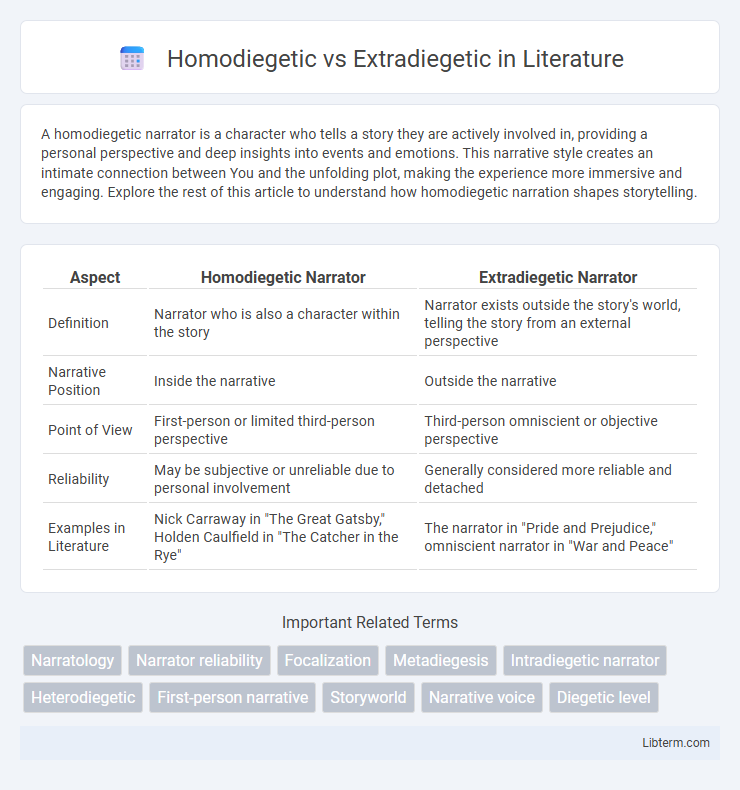A homodiegetic narrator is a character who tells a story they are actively involved in, providing a personal perspective and deep insights into events and emotions. This narrative style creates an intimate connection between You and the unfolding plot, making the experience more immersive and engaging. Explore the rest of this article to understand how homodiegetic narration shapes storytelling.
Table of Comparison
| Aspect | Homodiegetic Narrator | Extradiegetic Narrator |
|---|---|---|
| Definition | Narrator who is also a character within the story | Narrator exists outside the story's world, telling the story from an external perspective |
| Narrative Position | Inside the narrative | Outside the narrative |
| Point of View | First-person or limited third-person perspective | Third-person omniscient or objective perspective |
| Reliability | May be subjective or unreliable due to personal involvement | Generally considered more reliable and detached |
| Examples in Literature | Nick Carraway in "The Great Gatsby," Holden Caulfield in "The Catcher in the Rye" | The narrator in "Pride and Prejudice," omniscient narrator in "War and Peace" |
Understanding Homodiegetic and Extradiegetic Narration
Homodiegetic narration occurs when the narrator is also a character within the story, providing a subjective perspective and often limited knowledge compared to omniscient narrators. Extradiegetic narration features a narrator who exists outside the story world, offering an external, often more reliable or comprehensive viewpoint. Understanding the distinction between homodiegetic and extradiegetic narrators is essential for analyzing narrative reliability, point of view, and the depth of character insight in literary texts.
Defining Homodiegetic Narrators
Homodiegetic narrators are characters who participate in the story they narrate, offering a subjective perspective grounded in personal experience. This narrative voice provides intimate insight into events and emotions, often limiting knowledge to what the narrator personally encounters. Contrastingly, extradiegetic narrators exist outside the story world, delivering an objective or omniscient account without direct involvement in the plot.
Exploring Extradiegetic Narrators
Extradiegetic narrators exist outside the story world, providing an external perspective that shapes the narrative without participating in events. Their omniscient viewpoint offers comprehensive insight into characters' thoughts and the overall plot, enhancing the depth and reliability of the storytelling. This narrative distance allows for objective commentary and thematic exploration beyond the characters' immediate experiences.
Key Differences Between Homodiegetic and Extradiegetic
Homodiegetic narrators are characters who participate in the story they narrate, providing a subjective viewpoint from within the narrative world. Extradiegetic narrators exist outside the story they tell, offering an external and often omniscient perspective on events and characters. The key difference lies in narrative position: homodiegetic narration is internal and limited by the narrator's knowledge, while extradiegetic narration is external and typically unrestricted in information.
Narrative Perspective and Reader Experience
Homodiegetic narrators participate as characters within the story, offering an intimate first-person perspective that shapes the reader's experience through subjective insight and emotional engagement. Extradiegetic narrators exist outside the story world, providing an omniscient or limited third-person point of view that allows readers to perceive events more objectively and with broader contextual understanding. This contrast in narrative perspective influences how readers relate to the story, either through personal involvement with the narrator's inner thoughts or through a more detached, comprehensive overview of the narrative.
Examples of Homodiegetic Narration in Literature
Homodiegetic narration occurs when the narrator is a character within the story, providing a first-person perspective that offers intimate insight into their thoughts and experiences. Classic examples include Holden Caulfield in J.D. Salinger's "The Catcher in the Rye" and Nick Carraway in F. Scott Fitzgerald's "The Great Gatsby," both narrating events they personally witness or participate in. This narrative style enhances subjectivity and deepens character development by aligning the reader closely with the narrator's point of view.
Examples of Extradiegetic Narration in Literature
Extradiegetic narration occurs when the narrator exists outside the story world, providing a perspective that is not part of the narrative events, as seen in classic novels like Jane Austen's *Pride and Prejudice*, where the narrator offers insights without participating in the plot. In Gabriel Garcia Marquez's *One Hundred Years of Solitude*, the extradiegetic narrator presents the Buendia family's saga with a panoramic and omniscient viewpoint that transcends individual characters. Such narration techniques enhance storytelling by offering an overarching perspective that deepens thematic complexity and maintains reader-objective distance.
Narrative Reliability and Subjectivity
Homodiegetic narrators participate in the story they recount, resulting in inherently subjective perspectives that may compromise narrative reliability due to personal biases and limited knowledge. Extradiegetic narrators exist outside the story world, often providing a more reliable and objective viewpoint, although they may still exhibit selective information disclosure. The degree of narrative reliability hinges on the narrator's positionality and the transparency of their subjectivity within the storytelling framework.
Impact on Plot Development and Structure
Homodiegetic narrators actively shape plot development by providing intimate insights as characters within the story, allowing readers to experience events through a subjective lens that influences tension and reliability. Extradiegetic narrators, positioned outside the story world, offer a broader, more objective perspective that structures the narrative with comprehensive knowledge of all characters and events, facilitating intricate plot construction and thematic layering. The choice between homodiegetic and extradiegetic narration directly affects narrative coherence, pacing, and the depth of reader engagement with the plot.
Choosing the Right Narrative Voice: Homodiegetic vs Extradiegetic
Choosing the right narrative voice involves understanding the distinction between homodiegetic and extradiegetic narrators, where a homodiegetic narrator is a character within the story presenting a subjective perspective, and an extradiegetic narrator exists outside the story world, offering an omniscient or objective viewpoint. Homodiegetic narration creates intimacy and personal insight, often utilizing first-person pronouns, while extradiegetic narration allows for broader storytelling scope with third-person perspectives. Writers select homodiegetic narration for immersive character-driven tales and extradiegetic narration for comprehensive, multifaceted narratives.
Homodiegetic Infographic

 libterm.com
libterm.com